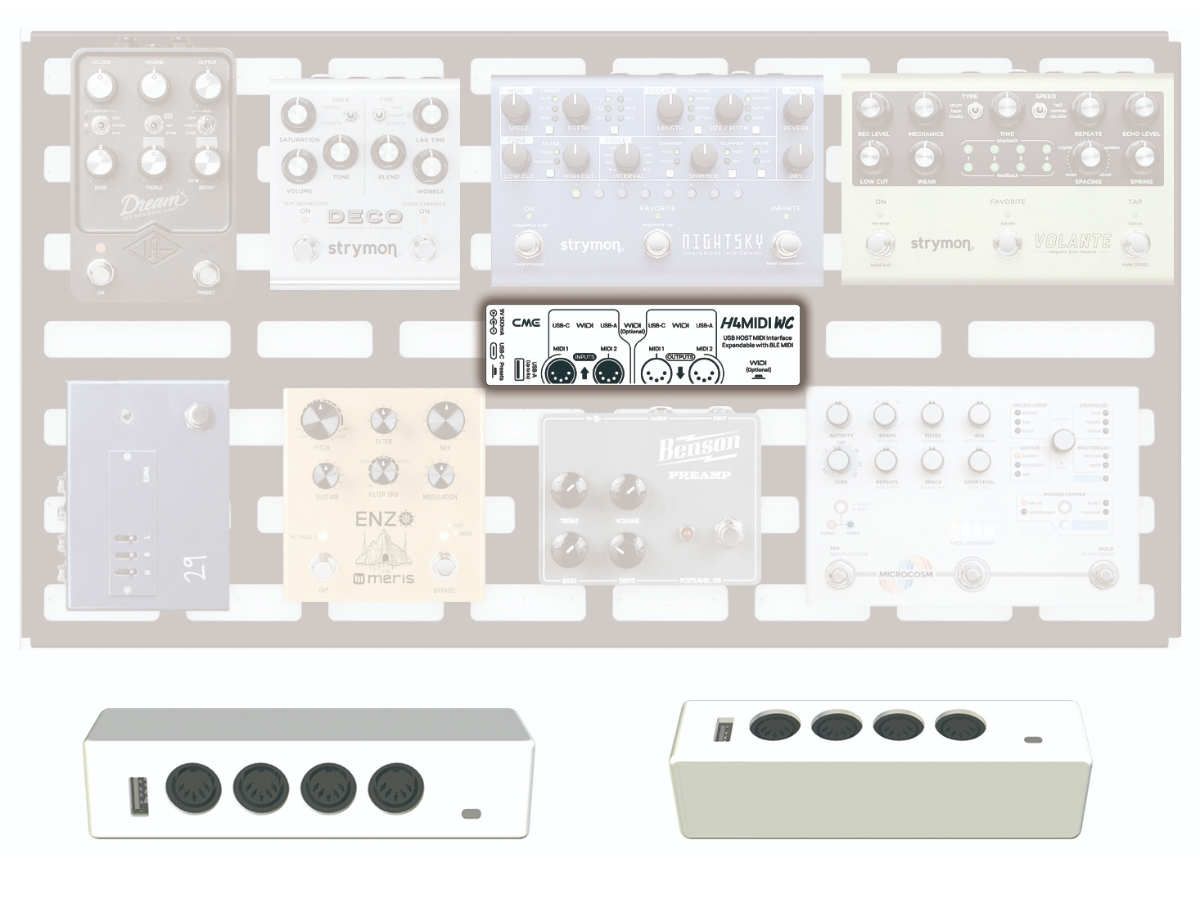Unlocking Limitless MIDI Possibilities: H4MIDI WC
The Advanced USB Host MIDI Interface
The USB MIDI Versus MIDI I/O Dilemma
In the intricate realm of USB technology, devices assume distinct roles: hosts and clients. Much like a computer serving as the host and peripherals acting as clients, many MIDI controllers function solely as USB clients, relying on a host for power and connectivity.
But what if you want to connect your USB MIDI keyboard directly to your synthesizer, circumventing the need for a computer? Or how will you manage multiple USB MIDI-enabled devices in a pedalboard while maintaining a clean setup?
Solving MIDI Connection Challenges with the H4MIDI WC
Introducing the H4MIDI WC – your key to unlocking endless possibilities for your USB MIDI devices. With this Host for USB MIDI, you gain the ability to easily control synthesizers, samplers, effects, and more directly from your USB MIDI device.
Say goodbye to the hassles of relying on a computer and dealing with complex setups. With the H4MIDI WC, MIDI connection becomes a breeze, allowing you to focus on making music without the limitations of traditional USB MIDI setups.
Crowd Creation: Let your voice be heard!
Of course, the concept of the Host for USB MIDI is not new. That is why you are invited to embark on a journey of innovation with us!
On May 1, 2024, the first post was unveiled in our Facebook Community Group , marking the inception of what we now call the H4MIDI WC. Guided by feedback from the inner circle, the dev team swiftly developed three iterations within a single week.
Phase 1: Simple mode > USB HOST MIDI to 5-pin DIN without computer

In response to your valuable feedback, we are already thrilled to announce exciting expansions to our MIDI connectivity solutions.
While there's been interest in TRS MIDI ports, we're starting with 5-pin DIN MIDI ports and plan to introduce 5-pin DIN to TRS MIDI Type A cables, aligning with our current cable designs.
Drawing from our insights gained from WIDI Master and WIDI Jack , we recognize the importance of prioritizing the most widely used solution. Introducing TRS would necessitate additional components, potentially escalating costs or reducing the availability of 5-pin DIN ports.
Hence, our decision to concentrate solely on 5-pin DIN initially. We aim to provide tailored solutions upon request with TRS MIDI cables. This approach ensures you're not paying for unnecessary features and allows for seamless expansion as required. Explore our MIDI cable collection for more details .
Additionally, based on numerous requests for expanded USB host functionality, that is how the second design came to existence to meet your evolving needs.
Phase 2: Expand mode > Up to 8-in-8-out USB HOST ports and 2-in-2-out MIDI I/O
With your USB hub, you can effortlessly integrate up to 8 USB MIDI devices with bidirectional communication. There are many affordable USB hub solutions on the market, against a price point a small developer like CME can never beat. That is why, if you actually need it, you can expand via a 3rd party device. And if you do not need it, you do not need to pay for an integrated solution that is relatively expensive.
This connectivity extends to a 2-in-2-out MIDI interface, streamlining your setup without the need for an operating system. Plus, with the H4MIDI WC powering all connected devices via the hub, you'll enjoy seamless bidirectional communication across up to 10 devices.
After introducing this second concept, it became clear you wanted more....
Phase 3: Advanced mode > Integrate operating systems + standalone router, filter & mapper

Operating systems: macOS, iOS, Windows, Android, Linux, and ChromeOS
With phase 3 the latest enhancements to the H4MIDI WC, designed to elevate your MIDI experience to new heights.
By incorporating a USB-C port initially dedicated to powering the H4MIDI WC and connected USB clients, we've expanded its capabilities to 4 virtual MIDI ports via USB-C to your operating system. This breakthrough allows seamless connectivity with major operating systems such as macOS, iOS, Windows, Android, Linux, and ChromeOS.
Configuration software: Router, Filter & Mapper
That's not all. With this update comes the introduction of our groundbreaking software: HxMIDI Tools. This innovative tool empowers you to take full control of your H4MIDI WC's settings, providing unprecedented flexibility and customization.
Drawing from the expertise of routing, filtering, and mapping software available for our U2MIDI Pro and U6MIDI Pro , HxMIDI Tools enables you to create merges, splits, and configure your own routing with ease. Additionally, you'll have the ability to filter and remap MIDI messages, akin to our renowned UxMIDI Tools .
4 Presets: programmable with physical switch for standalone scenarios
Perhaps the most exciting feature of HxMIDI Tools is the creation of 4 different presets, each fully customizable with your preferred routing, mapping, and filtering configurations. With the H4MIDI WC, you can effortlessly switch between presets using the dedicated preset button, providing seamless control without the need for continuous operating system connection.
Experience the next level of MIDI control and versatility with H4MIDI WC and HxMIDI Tools – where innovation meets convenience.

Draft graphic design: HxMIDI Tools advanced router for USB MIDI, OS, BLE MIDI and MIDI hardware with filtering and mapping
H4MIDI WC: The current state of the crowd creation process (updated May 14, 2024)
As the crowd creation process progresses, we're excited to share the current state of the H4MIDI WC's main features:
- Up to 8-in-8-out HOST ports via USB-A
- 2-in-2-out MIDI I/O ports via 5-pin DIN MIDI
- 4-in-4-out virtual MIDI ports via USB-C for any OS
- 1-in-1-out optional Bluetooth MIDI via WIDI Core expansion
- HxMIDI Tools with router, mapper, filter and 4 switchable presets
One of our primary goals in developing the H4MIDI WC is affordability. You'll only pay for the features you need, keeping the core design simple, compact, and, most importantly, budget-friendly.
Moreover, if you prefer working with a computer, it's entirely optional. You can seamlessly integrate the H4MIDI WC into your setup without the need for a computer, or utilize its external power option via USB-C for added flexibility.
Stay tuned for further updates as we continue to refine and enhance the H4MIDI WC based on your valuable feedback!
Phase 4: Smart mode > Adding convenience with innovatie design and features

Following your valuable feedback, the next iteration has been finalised, incorporating the following features:
- Dual power supply
5v USB power bank for mobile application.
9v DC power supply for guitar pedals. - 11 smart LED indicators
Clear indicators for each input and output, ensuring seamless connectivity at a glance. - WIDI Bluetooth MIDI
Ultra-low Latency Premium Bluetooth MIDI via optional WIDI Core with WIDI Groups via WIDI App
The inclusion of WIDI Core as an optional feature for Bluetooth MIDI expansion ensures cost-effectiveness while allowing for customisable upgrades.
Shaped with guitarists in mind, the compact dimensions (140mm x 38mm x 33mm) accommodate cramped pedalboards with a slim, reversible design.
With a dual power option delivering either 1A via 9v or 5v USB, and 11 indicator LEDs for clear MIDI operation monitoring, the H4MIDI WC priorities functionality both in studio and on stage.
Next step will be the final design, colouring and of course pricing......
Stay tuned!

Phase 5: Design Mode > The final design is here!
The complete product design and its final features can be found on the official H4MIDI WC product page !
Explore the ongoing discussions, leave your feedback in the comment section below and stay tuned for real-time updates in this blog.
Last update: May 21, 2024








